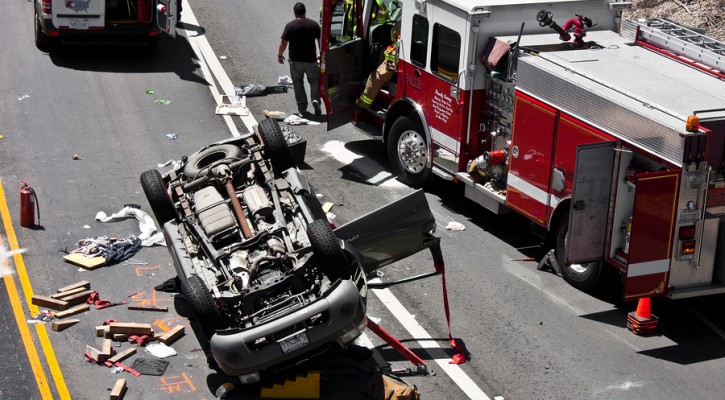Category Archive: Driving Skills

Real Life Hazards Best Driving Experience for Teens
November 26, 2007
Having rain in the forecast is sometimes a good thing when teens are taking a defensive driving course like the one the Mid-Ohio Sports Car Course offers. It just adds one of the elements of driving conditions that teenagers should be prepared for as they learn to drive, especially defensively.
This defensive driving course is for both parents and teens and it can be quite an eye opener, not only for the new teen drivers but for the experienced parent as well. Teen drivers and their parents are put through the paces with such drills as braking when the roads are wet, changing lanes in an emergency and even how to get out of a skid. For the skid drills, there are special cars that are purposely set up to skid so that the teens can learn what it feels like, the panicky feeling they get when it happens and how to push past all that and come out of the skid safely as possible.
When parents don’t have as much time as they should to teach their teens practical on-the-road driving, this defensive driving course can help fill in some blanks. After all, parents are not likely going to allow their teens to skid or drive in the rain in the family car! However, with the course, the instructors want teens to screw up because it will be in a controlled course and they will learn from the mistakes as well as that of others too.
Parents don’t know everything, although they may pretend that they do with their teenagers. So this defensive driving course is a definite eye opener for both parties. Teenagers will have to deal with situations that the parents will never think of, which can be a bit disconcerting for the grown-ups. In a country where as many as 25-30 teens die every day due to vehicle accidents, adding a driving test to your “resume” is a smart move.
While teens crave the independence that the open road will bring, they will not likely think about any potential road hazards they may encounter. They are thinking about switching the CD in the car or finding the windshield wiper switch. The problem is that one small distraction could cause a situation where an accident can occur. With the defensive driving course, hopefully those lessons will kick in instinctively for teens and avert a disaster.
That is the whole purpose for the defensive driving course. It is but another tool of many in the quest to build a safe teenage driving population. The only thing that would be better is making driver’s education a mandatory class once again in school so that each and every teen will have an equal opportunity to learn safe driving habits.

Cool Driving Incentive Makes a Big Teen Impression at a Georgia Fair
October 23, 2007
The Georgia National Fair this year had its requisite rides, games, entertainment and of course, plenty of cotton candy. However, there was an added element that really drew teen crowds – a safe teen driving booth set up in a joint partnership between the Safe America Foundation and the Houston County District Attorney’s Office. Say what? Teens willingly going to an educational booth about safe driving? Well, if the prize was a new car, would you believe it then?
The partnership between the America Foundation and the Houston County District Attorney’s Office was very successful hundreds of teens got the chance to go through a series of simulated driving tests to gauge their driving skills in a variety of situations. In addition, there were some question and answer sessions as well. There was a different round every day with teens progressing through each round until the final test – with a brand new car as the prize. This time a lucky 15 year old won after she successfully proved her safe driving skills and beat out hundreds of other teens.
It is the hope of both parties in this partnership that all of the teens who participated left with a greater sense of accomplishment and confidence in their skills and also walk away with the knowledge of what they need to brush up on in terms of driving skills. Finally, both the Safe America Foundation and the Houston County District Attorney’s Office hope that these teens feel a great sense of responsibility and realize that driving is a privilege that must be earned by good driving behavior.
A few teens who were interviewed after their participation felt that the experience was worth it. Of course, many of them admitted that they would not have stopped by either if it weren’t for the lure of winning a car. This is an understandable position and expected of many teens that live in the moment and don’t really think ahead to the consequences of some of their actions. However, the Safe America Foundation feels that if even just a few teens leave this experience changed, it would have been worth it.
This approach to promoting safe teenage driving is definitely different and applies a different spin to what so many other foundations and entities are trying to do – save our teens from driving accidents and death. Let’s hope that the lessons learned during this 11-day fair actually make a lasting impact with all the teens who participated.

Waking Teens to the Positives of Driving Safe
August 27, 2007
The state of Georgia is taking a novel approach to promoting teen driving safety. At their Georgia National Fair, a special contest is taking place to challenge teens on the ins and outs of driving safety. There is a written test about drunk driving as well as a series of simulated driving tests. The ultimate winner will drive home in a new VW bug.
The Houston Country District Attorney’s office in Georgia has had booths about safe teen driving set up in the past with informative literature that was passed out to teen drivers. However, many people were quite sure that those teens never really read the information. With a collaboration of several entities including insurance giant GEICO, the contest concept to promote teen safety was born.
Some might say that the grand prize of a car is a kind of bribe and that once the contest is over, teens will just forget what they have learned in the contest. However, others feel that because teens live in the moment, they don’t really look ahead to what “might” be. They are not going to think about driving safety and how it can impact their future. However, by participating in the contest and going through various levels of simulated driving tests, it could be quite an eye opener for many self-absorbed teens.
It is often said that talking with teens you can expect 10% of the message to be retained. However, the hands-on approach is a lot more effective and the retention rate of the message could be as high as 90% or more. Granted, the whole driving age teen population of Georgia won’t participate in the contest, however, even the mention of the contest and what it is about may at the very least make teens more cognizant of their surrounding when behind the wheel.
Teens aged 15 to 18 with a learner’s permit or a driver’s license can participate in the contest hosted at the Georgia National Fair. The whole contest takes several days and each day teens are eliminated or passed on through depending on their performances on the simulated driving tests. If anything, the attention is likely to grow with each day of the fair and the hope is that more and more teens will visit the safe driving booth, even if they are not participating.
Again, some people feel that the prize of a car is a bribe for teens. However, when it comes to preserving teen lives on the road, any type of incentive within reason should be used. So if a car will lower teen driving fatalities, who is to say that it is wrong?
Lowest Price Traffic School offers online traffic school for tickets and driver education courses required to obtain a Florida learner’s permit. DMV approved and lowest price guarantee.
Parent-Teen Involvement Essential to the Drive Rite Keys to Smart Driving Program
August 23, 2007
There is a program in the Indianapolis area called the Drive Rite Keys to Smart Driving and it is being offered through the county sheriff’s office. This program is unique as it is a requirement for parents to monitor this course with their teenagers. What a novel idea – having parents take charge of their children’s driving! Instead of hoping that your teenager has gotten enough information through required driver’s education courses, this course is more comprehensive and takes six months to complete.
During the six-month course, teens learn responsible driving behavior, traffic safety, how to drive defensively, and how to handle an accident. Both parents and teens have to attend together and are taken through real world experiences as well as interactive lessons. Many parents feel that the course greatly enhances the regular curriculum they have studied through driver’s education.
The Drive Rite course also makes teenagers responsible for on-line assignments as well a driver’s logbook to write down all of their experiences while on the road. In addition, parents are required to monitor additional training outside the classroom behind the wheel of a car. With both parent and teen participation in this course, there should be no gray areas of understanding what a responsible driver really means. In fact, parents may get a few eye-openers as well. It never hurts to remind seasoned drivers of some of the safety rules because we all know that we can also be rather lax in driving habits!
The driving course is coordinated through Purdue University and while intense, only meets once a month for the six months. While the purpose of this class is to educate, it also does so much more. It gets both the parents and the teens talking to each other and relating how the other feels about driving, road responsibility and more. Even if either party doesn’t learn anything else, the Drive Rite class gets the parents and teens communicating which is sometimes half the battle.
The goal of the course is to help prevent teen deaths due to car accidents. Will this program work? Chances are that it will… at least for a while. With teens, those good habits have to be instilled early in order for them to stick whether they have others to distract them or not. Hopefully, with both the parents and the teens working together, the commitment to drive safely will stick far beyond the classroom walls.
Learn more about driver training and traffic school at Lowest Price Traffic School.
Behind the Wheel with the Tire Rack Street Survival Class
August 20, 2007
It seems that every state in the country is adopting or introducing new extracurricular driver’s education classes for teens. The death toll for teenage drivers is rather high across the country so classes such as the Tire Rack Street Survival are created to address the issue. Do these classes work or are they just another way for some company to make some money? How effective are these classes really?
While many classes like the Tire Rack Street Survival definitely educate young drivers, it is only through constant parental involvement that significant strides can be made in reducing the teenage driver death toll. Of course, these classes may work if more parents made their teens take them! Without the requirement of mandatory classes, not many teens are going to say, on their own, “oh I cannot drive as well as I should, maybe I should take a driver’s education safety class.” The only way that these classes will make a huge impact on dropping the teenage death tool is mandatory extracurricular driving classes like the Tire Rack Street Survival.
The Tire Rack class does more than just get parents a discount on their liability insurance. This class also teaches by example – behind the wheel of a car as well as the classroom. The material that is covered is real hands-on and you get to experience real world driving situations behind the wheel of your own car. It’s a great way to prepare teenagers about accidents and how to easily avoid them. Plus there is no need to adapt to a strange car either. Other advanced driving schools use simulated demonstrations or even a company car equipped to produce certain driving situations.
This class shows teenage drivers in real world time the consequences of their actions behind the wheel. They learn that every action, no matter how small, creates another action and so forth. So teens learn that split second they took to turn on the radio could be all that stands between them and a tombstone. These lessons that are learned should be ones that every teenager with a driver’s permit should have to receive. Unfortunately, this is not the case at all. Therein lies the problem.
In too many states, driver’s education has to be taken as an extra-curricular activity. So many times, teens do not even take a class and instead just study for and pass the written portion of the exam. Sure, their driving is evaluated but it is usually in a controlled setting. However, if mandatory classes were modeled after the Tire Rack Street Survival course or others, the overall fate of teenage drivers would be more optimistic.
